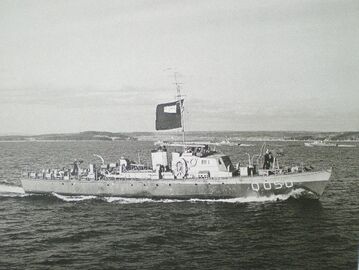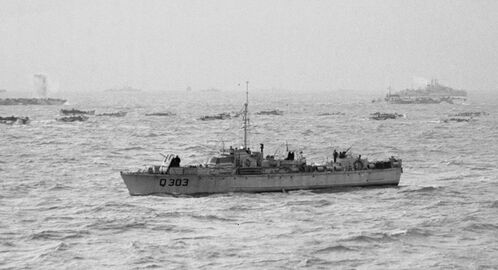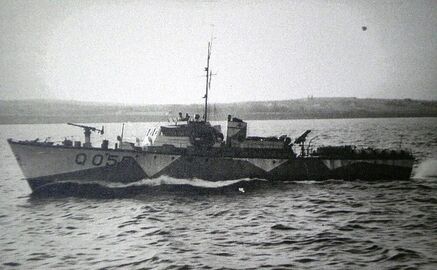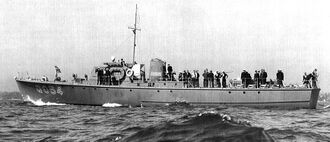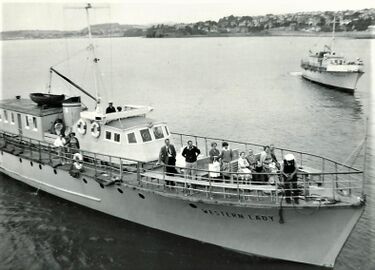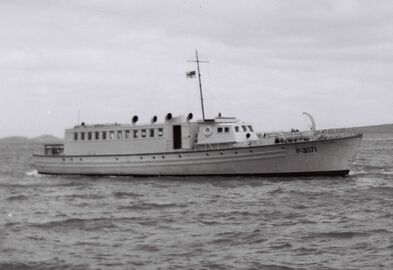Engineering:Fairmile B motor launch
 The Canadian Fairmile B motor launch ML-Q056 in 1941
| |
| Class overview | |
|---|---|
| Name: | Fairmile B motor launch |
| Preceded by: | Fairmile A motor launch |
| Succeeded by: | Fairmile C motor gun boat |
| Completed: | c. 650 |
| General characteristics | |
| Displacement: | 85 tons |
| Length: | 112 ft (34 m) |
| Beam: |
|
| Draught: | 4 ft 10 in (1.47 m) |
| Propulsion: | Two 650 bhp (480 kW) Hall-Scott Defender petrol engines |
| Speed: | 20 knots (37 km/h; 23 mph) |
| Range: | 1,500 mi (1,300 nmi; 2,400 km) at 12 kn (22 km/h; 14 mph) |
| Complement: | 16 (later increased) |
| Sensors and processing systems: | ASDIC |
| Armament: |
|
| Armour: | Wheelhouse plated |
The Fairmile B motor launch (often abbreviated to 'ML') was a large class of motor launch built by British boatbuilder Fairmile Marine and others during the Second World War to meet the Royal Navy's coastal operation requirements.
Design
While the Type A motor launch had been designed entirely by Fairmile, the Type B design had come from Bill Holt, head of the Admiralty's DNC Boat Section. The hard-chine hull of the Type A had exhibited seakeeping and handling limitations, but Holt's round-bilged design for the Type B was a far more seaworthy form.
Like all Fairmile boats, production of the Type B was based on total prefabrication so individual components could be contracted out to small factories for production and these arranged as kits that would be delivered in stages to various boatyards for assembly & fitting out on a 'just-in-time' basis. Accordingly, the detailed design work for the Type B was taken on by Fairmile and modified to suit their kit fabrication principle - they then also handled production of component parts.
Altogether approximately 650 boats were built between 1940 and 1945. Like the Type As, the Type Bs were initially intended as submarine chasers, so the boats were fitted with ASDIC (sonar) as standard.
Their main armament initially reflected their anti-submarine focus, with 12 depth charges, a single QF 3-pounder Hotchkiss gun forward, and one set of twin 0.303-in Lewis or GO machine guns (frequently increased in number by the crew); early boats often received a Holman projector amidships. A common upgrade to gun armament by 1942-43 in many early boats was to add an aft bandstand mounting for either a 2-pdr Rolls gun or a 20mm Oerlikon cannon. The specifications given are for the original 1940 British version.
As the war moved on, the vessels were adapted to other roles and the armament was modified and upgraded such as the replacement of the 3-pounder with one or more 20 mm Oerlikon cannon and removal of the ASDIC dome for more clearance as minesweepers. Some boats were configured as motor torpedo boats.
Boats
The Fairmile B type superseded the original Fairmile A type, which had been designed designed by Normman Hart. An initial batch of 24 of these (ML 101 to ML 124) was ordered by the Admiralty on 22 September 1939 from the Fairmile Marine company, of which the first eleven (plus the prototype ML 100) were completed to the Hart design; the remaining thirteen (ML 112 to ML 124) were completed to the Fairmile B design. The first Fairmile B motor launch (actually ML 113 from Tough Bros, Teddington) was completed and delivered on 12 August 1940, with a further eleven from this first production batch entering service before the end of the year (the last of the batch to be completed - ML 123 - was delayed until 1941).[1]
The Admiralty placed a massive order for a second batch of Fairmile Bs - 120 in total - on 8 January 1940. These were numbered ML 125 to ML 244. Of these, 37 were delivered by the end of 1940 and the other 83 during the first half of 1941. An order for a third batch, this time of 65 boats, was placed on 21 May 1940; these were numbered ML 245 to ML 309, and were all delivered during 1941, as were two extra units (ML 310 and ML 311) ordered on 28 June 1940 for Singapore to be assembled by the Singapore Harbour Board; this last pair were delivered to Singapore on 29 November 1941, only to be lost in February 1942 to the Japanese (who re-used ML 310 under the name Suikei 12).
The fourth batch of 24 boats was ordered on 28 July 1940 as ML 312 to ML 335. However, these were altered to be completed instead as Motor Gunboats, and the prefixes to their numbers changed from "ML" to "MGB", retaining the same numbers. In their place, a new batch of 50 Fairmile Bs was ordered on 21 August, and these became ML 336 to ML 367 (the last six of these for assembly by the Singapore Harbour Board) and ML 372 to ML 389. Six days later another 6 were ordered, ML 368 and ML 369 for the Royal Canadian Navy, ML 370 and ML 371 for assembly in Jamaica for Caribbean service, and ML 390 and ML 391 intended for assembly at Singapore, although this last pair was switched to Bombay Dockyard on 22 February 1942 following the fall of Singapore. Further batches followed, producing ML 392 onwards, mainly in Overseas yards, with a final total of about 650 boats of this Type eventually assembly worldwide, including 60 in Canada.
All boats were essentially the same, although they could be adapted to serve in several roles by the expedient of having pre-drilled rails on their decks spaced to allow the fitting of various types of armaments. Although their armament initially reflected their main anti-submarine mission, nine of them were fitted with 21-inch (533 mm) torpedo tubes taken from ex-US Town-class destroyers; they formed the 2nd ML Flotilla tasked with anti-invasion duty, until the threat had passed.
Service
During the Siege of Malta, they were used to sweep a narrow channel ahead of heavier minesweepers which widened the channel. The heavier minesweepers were initially the remnants of the Malta trawler force, then fleet minesweepers that arrived with a convoy from Gibraltar. The launches were able to pass over the mines whereas many trawler losses had been caused by the leading ship hitting a mine.[2]
A number served in the St Nazaire Raid as assault transports, but their light construction meant that they suffered heavily; 12 B motor launches were lost in the action,[3] out of 16 deployed.[4]
During the Normandy landings a number of MLs were designated as navigation launches. These motor launches guided the landing craft onto the correct beaches. For this task the craft were fitted with splinter mats at the front for added protection. An Oerlikon 20 mm cannon was fitted amidships and a Bofors 40 mm gun was installed at the stern. Smoke canister apparatus was installed at the rear of the craft and the number of depth charges was reduced.[5] See main picture above of ML303 in this configuration.
Many were built as rescue motor launches with small sickbays aft of the engine room coaming, and classified as RML (rescue motor launch). These were numbered in the series RML492 to RML500, and RML511 to RML553.[6] Several more were converted to use as War Office ambulance launches with larger sickbays.
British Colonial or Commonwealth-built Fairmile B motor launches
Canadian built Fairmiles
Originally designed for the Royal Navy (RN) by W.J. Holt of the British Admiralty and built by British boatbuilder Fairmile Marine, during the Second World War 88 Fairmile B motor launches, with slight modifications for Canadian climatic and operational conditions, were built in Canada for service with the RCN in home waters.[7] The first thirty-six Canadian Fairmile B type were designated and painted up as CML 01-36 (coastal motor launch).[8] Eight Canadian Fairmiles (Q 392-Q 399) were built by Le Blanc for the RN and were transferred under Lend-Lease to the US Navy. The US Navy used the Canadian-built Fairmiles as submarine chasers (SC1466-1473).[9]
Other British Colonial or Commonwealth built Fairmiles
At least two (ML 368 and ML 369) were built in the Imperial fortress colony of Bermuda, home to the base, dockyard and Admiralty house of the America and West Indies Station, by what was to become Burland, Conyers & Marirea, Ltd.[10][11]
New Zealand built 12 boats. These were used in New Zealand waters and around the Solomon Islands, and included HMNZS Maori and Kahu.
In Australia 35 boats entered service from October 1942. They were employed on routine patrols, convoy escorts, running special forces in and out of Japanese-held areas, in Papua New Guinea, boom defence patrols in harbours at home and abroad, courier operations, survey work, and raiding Japanese-held coasts. Of note the surrender of Japanese forces in the South West Pacific. On 10 September 1945, Rear-Admiral S. Sato, commanding officer of Kairiru and Muschu Islands, New Guinea, surrendered the Japanese forces on the islands to Major-General H. C. H. Robertson, commander of 6th Division on board the ML 805.[12]
At least six boats (ML380-383,829 and 846) were built by South Africa and commissioned during November 1942. These were sent as the 49th Fairmile Flotilla (SANF) to Burma and deployed along the Arakan coast. The boats saw much action in support of ground forces and disrupting Japanese supply lines.
The Imperial Japanese Navy salvaged two that had been sunk and placed them in service.
A number of boats were built in Egypt by Thomas Cook & Son, who had a Cairo shipyard for constructing Nile tourist craft. Armament was fitted in Port Said. The first three to enter service in 1942 were MLs 355, 353 and 348.[13] Post war they were often taken on as pleasure boats and a number of Fairmile Bs are on the National Register of Historic Vessels.
Fourteen Fairmile B were operated by the Italian Guardia di Finanza naval service, between 1947 and the 1980s.
Surviving examples
Four currently survive in the United Kingdom, two of which are in excellent condition. One is RML497. Many others of the type are known to survive around the world, some still in commercial service as tour boats.
- HMNZS Kahu, FML411, was used post war ferrying passengers at Auckland in New Zealand
See also
- Fairmile A motor launch
- Fairmile C motor gun boat
- Fairmile D motor torpedo boat
- Fairmile H landing craft
- Coastal Forces of the Royal Navy
- Coastal Forces of the Royal Canadian Navy
- R boat – slightly larger German equivalent
Notes
- ↑ Angus Konstam, British Motor Gun Boat 1939–45 Osprey Publishing Limited 2010, ISBN:978-1-84908-077-4 (p.15)
- ↑ A leaf upon the sea : a small ship in the Mediterranean, 1941-1943, Gordon W. Stead, University of British Columbia Press Vancouver 1988, ISBN:9780774802994, p.114
- ↑ Naval-History.net Royal Navy Vessels Lost at Sea, 1939-45 - by Date: January 1942 - December 1943 (Entry for 28 March)
- ↑ History of War - St. Nazaire, Raid on, (Operation Chariot), Part One
- ↑ Malcolm George Wright, British and Commonwealth Warship Camouflage of WWII Seaforth Publishing 2014, ISBN:978-1848322530 (p.137)
- ↑ Lenton and Colledge. Warships of World War II. Ian Allan. pp. 523–530.
- ↑ Heenan, RCNR (Ret), Captain Joseph A. (1 February 1962). "The Little Ships". The Crowsnest. http://readyayeready.com/crowsnest/1962/1962-02.pdf.
- ↑ Lambert and Ross, John and Al (1990). Allied Coastal Forces of World War II Vol 1: Fairmile designs and US submarine chasers. Conway Maritime Press. pp. 77–78. ISBN 0-85177-519-5.
- ↑ "WW2Ships.com: Fairmile Type B Motor Launch". http://www.ww2ships.com/britain/gb-sc-001-b.shtml.
- ↑ "HMCS ML 368 (ML 368)". Guðmundur Helgason. https://uboat.net/allies/warships/ship/14536.html.
- ↑ "HMCS ML 369 (ML 369)". Guðmundur Helgason. https://uboat.net/allies/warships/ship/14537.html.
- ↑ "Patrol boats". The Navy Contribution to Australian Maritime Operations: RAN Doctrine 2 - 2005. Royal Australian Navy. 9 January 2024. ISBN 978-0-642-29615-3. http://www.navy.gov.au/Publication:Navy_Contribution_to_Australian_Maritime_Operations.
- ↑ Searle, G. W. At Sea Level Book Guild 1994 pp47-8 ISBN:0863328970
References
- Allied Coastal Forces of World War Two, Volume I : Fairmile designs and US Submarine Chasers - by John Lambert and Al Ross - 1990, ISBN:978-0-85177-519-7
- War at Sea - South African Maritime Operations during World War II : CJ Harris - 1991
- Hudson, G. M. (2001). "Question 52/00: US Army Fairmile "B" Molor Launches". Warship International XXXVIII (4): 335. ISSN 0043-0374.
- Fairmile 'B' Class Launches Accessed 28 November 2007
- https://uboat.net/allies/warships/ship/14515.html ML347 built by Risdon Beazley Ltd NR Southampton became Eastern Princess at Great Yarmouth after the war and last heard of as a ferry in Skiathos.
External links
- Canadian Fairmile Q105 presently under restoration
- Fairmile Type B Motor Launch
- A Fairmile Submarine Chaser (photo of Fairmile B motor launch)
- Book on New-Zealand built Fairmiles used in New Zealand and the Solomons
- The Fairmiles, Canada's Little Ships by Spud Roscoe
- Stoker Harold Siddall Royal Navy, his service in ML.1030 and capture in Crete 1941 at naval-history.net
- Pictures of Fairmile models
- List of books at PT-boats.com
- Little ships
- Fairmile Radio Fit by Jerry Proc
- Canada's Little Ships by Spud Roscoe
 |
